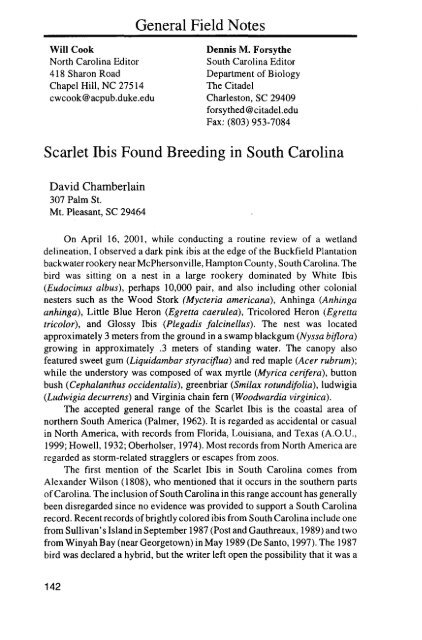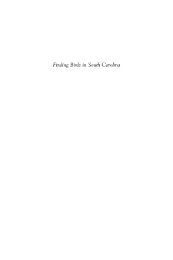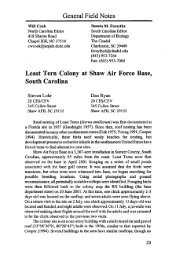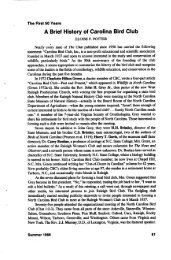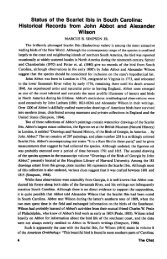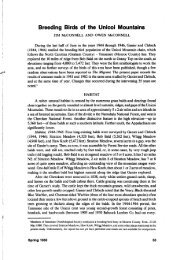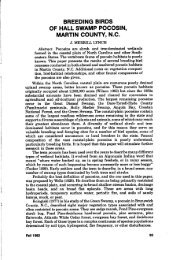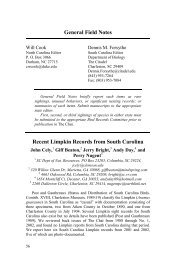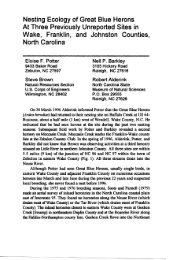Scarlet Ibis Found Breeding in South Carolina - The Carolina Bird ...
Scarlet Ibis Found Breeding in South Carolina - The Carolina Bird ...
Scarlet Ibis Found Breeding in South Carolina - The Carolina Bird ...
You also want an ePaper? Increase the reach of your titles
YUMPU automatically turns print PDFs into web optimized ePapers that Google loves.
General Field NotesWill CookNorth Carol<strong>in</strong>a Editor418 Sharon RoadChapel Hill, NC 27514cwcook@acpub.duke.eduDennis M. Forsythe<strong>South</strong> Carol<strong>in</strong>a EditorDepartment of Biology<strong>The</strong> CitadelCharleston, SC 29409forsythed@citadel.eduFax: (803) 953-7084<strong>Scarlet</strong> <strong>Ibis</strong> <strong>Found</strong> <strong>Breed<strong>in</strong>g</strong> <strong>in</strong> <strong>South</strong> Carol<strong>in</strong>aDavid Chamberla<strong>in</strong>307 Palm St.Mt. Pleasant, SC 29464On April 16, 2001, while conduct<strong>in</strong>g a rout<strong>in</strong>e review of a wetlanddel<strong>in</strong>eation, I observed a dark p<strong>in</strong>k ibis at the edge of the Buckfield Plantationbackwater rookery near McPhersonville, Hampton County, <strong>South</strong> Carol<strong>in</strong>a. <strong>The</strong>bird was sitt<strong>in</strong>g on a nest <strong>in</strong> a large rookery dom<strong>in</strong>ated by White <strong>Ibis</strong>(Eudocimus albus), perhaps 10,000 pair, and also <strong>in</strong>clud<strong>in</strong>g other colonialnesters such as the Wood Stork (Mycteria americana), Anh<strong>in</strong>ga (Anh<strong>in</strong>gaanh<strong>in</strong>ga), Little Blue Heron (Egretta caerulea), Tricolored Heron (Egrettatricolor), and Glossy <strong>Ibis</strong> (Plegadis falc<strong>in</strong>ellus). <strong>The</strong> nest was locatedapproximately 3 meters from the ground <strong>in</strong> a swamp blackgum (Nyssa biflora)grow<strong>in</strong>g <strong>in</strong> approximately .3 meters of stand<strong>in</strong>g water. <strong>The</strong> canopy alsofeatured sweet gum (Liquidambar styraciflua) and red maple (Acer rubrum);while the understory was composed of wax myrtle (Myrica cerifera), buttonbush (Cephalanthus occidentalis), greenbriar (Smilax rotundifolia), ludwigia(Ludwigia decurrens) and Virg<strong>in</strong>ia cha<strong>in</strong> fern (Woodwardia virg<strong>in</strong>ica).<strong>The</strong> accepted general range of the <strong>Scarlet</strong> <strong>Ibis</strong> is the coastal area ofnorthern <strong>South</strong> America (Palmer, 1962). It is regarded as accidental or casual<strong>in</strong> North America, with records from Florida, Louisiana, and Texas (A.O.D.,1999; Howell, 1932; Oberholser, 1974). Most records from North America areregarded as storm-related stragglers or escapes from zoos.<strong>The</strong> first mention of the <strong>Scarlet</strong> <strong>Ibis</strong> <strong>in</strong> <strong>South</strong> Carol<strong>in</strong>a comes fromAlexander Wilson (1808), who mentioned that it occurs <strong>in</strong> the southern partsof Carol<strong>in</strong>a. <strong>The</strong> <strong>in</strong>clusion of <strong>South</strong> Carol<strong>in</strong>a <strong>in</strong> this range account has generallybeen disregarded s<strong>in</strong>ce no evidence was provided to support a <strong>South</strong> Carol<strong>in</strong>arecord. Recent records of brightly colored ibis from <strong>South</strong> Carol<strong>in</strong>a <strong>in</strong>clude onefrom Sullivan's Island <strong>in</strong> September 1987 (Post and Gauthreaux, 1989) and twofrom W<strong>in</strong>yah Bay (near Georgetown) <strong>in</strong> May 1989 (De Santo, 1997). <strong>The</strong> 1987bird was declared a hybrid, but the writer left open the possibility that it was a142
<strong>The</strong> Chat, Vol. 65, No.4, Fall 2001 143<strong>Scarlet</strong> <strong>Ibis</strong> breed<strong>in</strong>g <strong>in</strong> Hampton County, SC.Photos by Murry Thompson.
144 <strong>Scarlet</strong> <strong>Ibis</strong> <strong>Breed<strong>in</strong>g</strong> <strong>in</strong> SC<strong>Scarlet</strong> <strong>Ibis</strong> <strong>in</strong> faded plumage (Post and Gauthreaux, 1989; Belser, 1989). Noneof these birds was found nest<strong>in</strong>g.<strong>The</strong> ibis found at Buckfield Plantation backwater was a dark, vivid p<strong>in</strong>k,Smithe color 13 - geranium p<strong>in</strong>k with black w<strong>in</strong>g tips (Smithe, 1975). Thiscolor is but one hue off of scarlet (color 14). <strong>The</strong> feet, legs, lores, and orbitalarea of this bird were bright scarlet. <strong>The</strong> color of the soft parts of this bird wasmuch deeper than those of the white ibis nest<strong>in</strong>g nearby. <strong>The</strong> bill was darkbrown grad<strong>in</strong>g <strong>in</strong>to p<strong>in</strong>k near its base. <strong>The</strong> iris was blue.<strong>The</strong> identification of this bird is complicated by the question of whetherit is a <strong>Scarlet</strong> x White <strong>Ibis</strong> hybrid or whether it is a <strong>Scarlet</strong> <strong>Ibis</strong> <strong>in</strong> fadedplumage. Discussion of the plumage is further complicated by the fact that the<strong>Scarlet</strong> <strong>Ibis</strong> takes three to four years to obta<strong>in</strong> its full adult plumage but may besexually mature at three years (Bent, 1926). In <strong>South</strong> America, the older, bloodred adults are known to nest first followed by those <strong>in</strong> faded plumages,support<strong>in</strong>g the assertion that not all nest<strong>in</strong>g <strong>Scarlet</strong> <strong>Ibis</strong> are <strong>in</strong> full adult plumage(Bent, 1926).<strong>Scarlet</strong> <strong>Ibis</strong> x White <strong>Ibis</strong> hybridization is noted by Selby (2000), whodescribes the plumage as "variable rosy-p<strong>in</strong>k." Careful exam<strong>in</strong>ation of thephotographs by Dr. Dennis Forsythe led him to support the identification <strong>in</strong>favor of the "true" <strong>Scarlet</strong> <strong>Ibis</strong> rather than the hybrid. <strong>The</strong> plumage of thisparticular specimen is <strong>in</strong> keep<strong>in</strong>g with the third nuptial described by Oberholseras "similar to nuptial adults, but head and neck paler - peach red to rose red."Additionally, this species is known to lose its color rapidly <strong>in</strong> captivity,result<strong>in</strong>g <strong>in</strong> a rose tone rather than the deep scarlet found <strong>in</strong> <strong>South</strong> America.This phenomenon has been attributed to a lack of carotenoids <strong>in</strong> the diet, anitem formerly supplied by tropical crustaceans abundant <strong>in</strong> coastal <strong>South</strong>American waters (Bent, 1926; Fox, 1962). Given the fact that plumage color isdeterm<strong>in</strong>ed by the diet at the time the feathers were acquired, it seems apparentthat this bird traveled a considerable distance from a tropical locale (<strong>Bird</strong>,1997).One puzzl<strong>in</strong>g aspect of the identification was the iris color. Palmerdescribes the <strong>Scarlet</strong> <strong>Ibis</strong> iris as "very dark brownish." <strong>The</strong> iris of this bird wasblue, as is that of the White <strong>Ibis</strong>. Dr. Richard Banks of the SmithsonianInstitution questioned if Palmer was correct s<strong>in</strong>ce no other authors offer an iriscolor. He also postulated that eye color may be related to age (Banks, 2001).<strong>The</strong> bird was extensively photographed with both 300 mm and 400 mmlenses by the author and Dr. Murry Thompson on April 16 and aga<strong>in</strong> on April18,2001. (Photos page 142.) <strong>The</strong> bird was last observed on April 20. A strongw<strong>in</strong>dstorm passed through the area on April 22, and a revisit to the site on April30 found the nest and those of adjacent White <strong>Ibis</strong> destroyed and much of therookery abandoned.<strong>The</strong> immature <strong>Scarlet</strong> <strong>Ibis</strong>, like the White <strong>Ibis</strong>, is known to disperse overgreat distances (Palmer, 1962). Depri ved of the tropical mar<strong>in</strong>e crustaceans thatprovide vivid plumage, this bird was fad<strong>in</strong>g as it adapted to life <strong>in</strong> theLowcountry of <strong>South</strong> Carol<strong>in</strong>a. If this <strong>in</strong>dividual is determ<strong>in</strong>ed to be a <strong>Scarlet</strong>
<strong>The</strong> Chat, Vol. 65, No.4, Fall 2001 145<strong>Ibis</strong> (Eudocimus ruber), it will be the first recorded <strong>in</strong> <strong>South</strong> Carol<strong>in</strong>a and thefirst to have been found nest<strong>in</strong>g <strong>in</strong> the state.LiteratureCitedAmerican Ornithologists Union, 1998. Checklist of North American <strong>Bird</strong>s, 7thed., Wash<strong>in</strong>gton, D.C., <strong>The</strong> Union.Banks, Richard, National Museum of Natural History, personal communication,June 1,2001.Bent, A C. 1926. Life histories of North American marsh birds, SmithsonianInstitution, United States National Museum Bullet<strong>in</strong> 135, Wash<strong>in</strong>gton,DC.Belser, C G. 1989. <strong>Scarlet</strong> ibis or hybrid white ibis x scarlet ibis <strong>in</strong> <strong>South</strong>Carol<strong>in</strong>a. Chat 53:90-91.<strong>Bird</strong>, D M. 1997. Colorful birds, <strong>Bird</strong> Watcher's Digest 20:118.De Santo, T. 1997. P<strong>in</strong>k and orange ibises <strong>in</strong> Coastal Georgetown County,<strong>South</strong> Carol<strong>in</strong>a. Chat 61 :54-56.Forsythe, D M. <strong>The</strong> Citadel, personal communication, July 2001.Fox, D L. 1962. Carotenoids of the scarlet ibis. Compo Biochem. Physiol. 5:31-43.Howell, A H. 1932. Florida bird life. Florida Department of Game andFreshwater Fish and Bureau of Biological Survey, United StatesDepartment of Agriculture, NY.Oberholser, H C. 1974. <strong>Bird</strong> life of Texas. University of Texas Press, Aust<strong>in</strong>.Palmer, R S (ed.). 1962. Handbook of North American <strong>Bird</strong>s. Yale UniversityPress, New Haven.Post, Wand S A Gauthreaux, Jr. 1989. Status and distribution of <strong>South</strong> Carol<strong>in</strong>a<strong>Bird</strong>s: Contributions from the Charleston Museum, XVIII, Charleston.Sibley, D A. 2000. Sibley guide to birds. National Audubon Society, AlfredKnopf, New York.Smithe, F B. 1975. Naturalist's color guide. American Museum of NaturalHistory, NY.Wilson, A. 1808-1818. American Ornithology, 8 vols., Bradford and Inskeep,Philadelphia.CBC Rare <strong>Bird</strong> Alert(704) 332-BIRD


